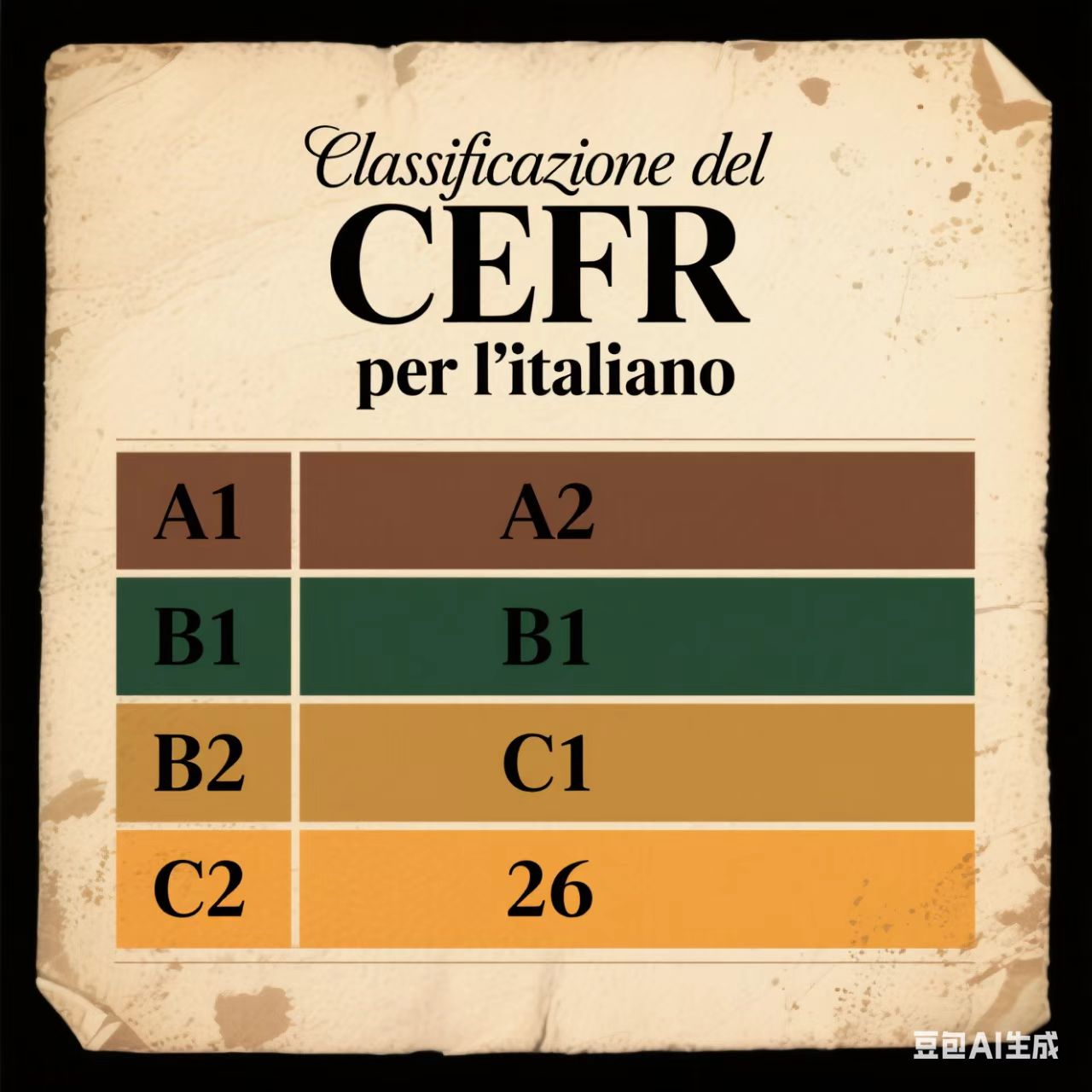
I. Level setting
According to the CEFR standard, Italian proficiency is divided into six levels A1-C2. The description of each level and vocabulary requirements are as follows:
Level corresponds to CEFR level vocabulary requirements ability description
A1 Beginner level about 300 words can understand and use basic greetings, self-introduction and other simple sentences, complete shopping, filling in forms and other daily tasks.
A2 Basic level about 600 words can describe personal experience, express needs, understand simple notifications, deal with travel planning, medical treatment and other scenarios.
B1 Intermediate about 1500 words can express opinions independently, participate in work meetings or academic discussions, handle letters and reports, complete business mail writing, etc.
B2 Advanced about 3000 words can understand complex texts, conduct business negotiations or academic papers, and deal with professional scenarios such as policy document interpretation.
C1 Advanced about 5000 words can deal with legal documents, conduct academic research, master professional terms, and fluently deal with complex situations.
C2 Proficient level native language level can carry out literary creation, simultaneous interpretation, understand implicit meaning, and use language freely.
2. Examination content
(1) Listening comprehension
A1-A2: slow speaking speed, content is daily conversation (such as shopping, greeting), short notice, questions include multiple choice, matching questions, focus on the understanding of basic vocabulary and simple sentence structure.
B1-B2: Add news, stories, lectures and other content. The speaking rate is moderate. The questions include fill-in-the-blank questions and short-answer questions to test the ability of detail retrieval and induction.
C1-C2: Academic lectures, film and television original sounds, etc., with fast speaking speed, involving professional terms and complex sentences, and examining logical relationship and deep meaning through multiple choice questions and listening review questions.
(2) Oral expression
A1-A2: Human-computer dialogue, reading words and short sentences, and answering simple questions (such as introducing the family). The focus is on accurate pronunciation and basic vocabulary use.
B1-B2: Video recording or real-time dialogue, describing a given topic (such as "travel experience"), participating in situational dialogue, and examining grammatical correctness and fluency of expression.
C1-C2: In-depth discussion with the examiner on a professional topic (such as "the impact of artificial intelligence on society"), give a speech, and assess the naturalness of language organization, logical thinking, and voice tone.
(3) Reading comprehension
A1-A2: simple short passages with pictures, multiple choice and matching questions to test basic comprehension ability.
B1-B2: covers narrative, expository and other genres. The length increases, with fill-in-the-blank questions and short-answer questions to test the understanding of the main idea and details.
C1-C2: It involves academic papers, literary works and so on. The questions include multiple choice questions and article summary questions, which examine the ability of analysis, generalization and critical thinking.
(4) Writing ability
A1-A2: Write simple words and sentences, describe a scene according to the picture (such as "describe a family photo"), examine the use of basic grammar.
B1-B2: Write short articles (such as "My Day"), letters and other applied texts, requiring coherent language and complete content.
C1-C2: Writing argumentative essays and academic reports, with clear viewpoints, sufficient evidence and clear logic (such as "The Influence of Italian Culture on the World"), to examine advanced language skills and depth of thought.
3. Examination form
1. Listening and written test: online computer test, time limit to complete, automatic timing and paper collection by the system, support for special Italian characters (such as "a" and "e").
2. Oral test: real-time video call, scored by native Italian speaking examiner, or assisted by intelligent oral assessment system.
Iv. Scoring criteria
1. Listening and reading: Objective questions are graded according to the correct or incorrect answers, while subjective questions are graded according to the completeness of key points, language accuracy and other dimensions, and are evaluated by teachers manually.
2. Oral: Quantitative scoring is based on pronunciation (30%), fluency (30%), grammar (20%), vocabulary (10%), and content (10%), with reference to official test standards such as CELI and CILS.
3. Writing: The score is 100 points in three aspects: content (clear viewpoints, sufficient evidence), structure (clear logic) and language (rich vocabulary, correct grammar). Each module should reach more than 60 points to pass.
V. Examination schedule
1. Regular exams: All levels of exams will be organized at fixed times every quarter (such as March, June, October and December), and the plan will be announced two months in advance to facilitate candidates' preparation.
2. Test immediately: For A1-A2 level, the test will be arranged within 7 days after the successful registration of candidates, providing flexible choice.
Certification and Cooperation
Official cooperation: cooperate with Italian University of Foreigners in Perugia (CELI), University of Foreigners in Siena (CILS), Dante Association (PLIDA) and other institutions to issue internationally recognized certificates to enhance the authority of the examination.
Validity of the result: The certificate is valid for life. Those who fail in a single subject can take a make-up exam within 1 year, and the result will be retained until the next test.
Vii. Technical support
1. Anti-cheating measures: Camera monitoring, screen recording, browser locking and other technologies are adopted to ensure the fairness of the exam by combining AI algorithm to identify abnormal behaviors.
2. Support for special characters: The test system is compatible with Italian input, providing virtual keyboard or shortcut key switch to ensure that candidates can answer questions smoothly.
8. Preparation resources
1. Official real questions: CELI and CILS past real questions and simulated questions are provided, covering all types of listening, reading, writing and speaking.
2. Learning tools: It is recommended to use textbooks such as New Vision Italian and Italian Grammar, and combine Duolingo, ItalianPod101 and other APPs for fragmented learning.
3. Oral training: Improve practical ability through role-playing, simulated oral test by foreign teachers, and correct pronunciation by referring to Forvo pronunciation dictionary.

Cool Mango focuses on the online language teaching and learning with all foreign teachers for multiple languages. It aims to popularize online language teaching and learning globally, recruit and train professional teachers worldwide, and create the unique Cool Mango teaching method. It builds an efficient language learning mode and environment with real teaching by native foreign teachers and real-time translation assistance of AI, providing high-quality online language courses and online communication platform for everyone.
 |
  |
  |
Copyright © Cool Mango Co. Ltd. All Rights Reserved. / Privacy Statement / User-agreement











